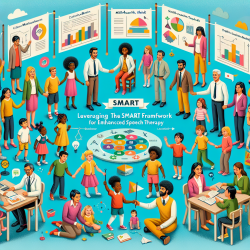Introduction to the SMART Framework
The SMART Framework, as detailed in the research article "The SMART Framework: Integration of Citizen Science, Community-Based Participatory Research, and Systems Science for Population Health Science in the Digital Age," offers a robust approach to enhancing population health research. By integrating citizen science, community-based participatory research, and systems science, the framework provides a comprehensive method for addressing complex health issues.
Application in Speech Therapy
For speech-language pathologists, particularly those working with children, the principles of the SMART Framework can be transformative. By incorporating citizen science, practitioners can engage parents and caregivers in the data collection process, thereby gaining a more holistic understanding of a child's communication environment. This participatory approach ensures that interventions are tailored to the specific needs of each child, improving the likelihood of successful outcomes.
Community-Based Participatory Research
Community-based participatory research (CBPR) emphasizes the importance of involving community members in the research process. For speech therapists, this means collaborating with families, educators, and other stakeholders to co-create intervention strategies. By doing so, therapists can ensure that their approaches are culturally relevant and aligned with the community's values and needs.
Systems Science in Speech Therapy
Systems science offers a framework for understanding the complex interactions between various factors that influence a child's speech and language development. By utilizing big data and advanced computational models, therapists can identify patterns and causal relationships that may not be apparent through traditional methods. This data-driven approach allows for more precise and effective interventions.
Challenges and Solutions
Implementing the SMART Framework in speech therapy does come with challenges, such as ensuring data privacy and managing the logistics of community engagement. However, these can be addressed through careful planning and the use of digital tools that facilitate secure data collection and analysis. By overcoming these hurdles, speech therapists can harness the full potential of the SMART Framework to improve child outcomes.
Encouraging Further Research
For practitioners interested in further exploring the SMART Framework, I encourage you to delve into the original research paper. Understanding the theoretical underpinnings and practical applications of this framework can provide valuable insights into how it can be adapted to your specific practice.
To read the original research paper, please follow this link: The SMART Framework: Integration of Citizen Science, Community-Based Participatory Research, and Systems Science for Population Health Science in the Digital Age.










